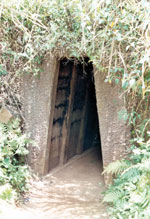Tunnels lead to survival during wartime

Tunnels like these in Vinh Moc display the Vietnamese ingenuity during war.
One common lesson learned by foreign armies that have fought in Vietnam over the centuries, including the Chinese, the French and the Americans, is that overwhelming military might alone was not enough to defeat the Vietnamese.
The combination of ingenuity and determination has proven to be the key for the Vietnamese time and time again in defeating foreigners, regardless of the powers that be in the country. Two examples of this resolve are on display 27 years after the fall of Saigon in the form of extensive tunnel systems, one in Vinh Moc in the DMZ and the other in Cu Chi in the south near Saigon.
The quiet fishing village of Vinh Moc became a crucial strategic place for the North during the war against the Americans. Supplies were shipped by the North to Con Co Island about 15 miles off the coast from the village. Weapons were then sent piecemeal to Vinh Moc. The United States knew this, so the village became a target for bombers. As a result, the residents spent 600 days beginning in 1966 digging a mile-long tunnel network by hand.
There are three levels, consisting of supply (weapons) rooms, kitchens, a “maternity room,” four wells and 13 entrances. The bomb shelters were dug 80 feet deep and were reached by sliding down a slippery earthen ramp. Vinh Moc was an ideal spot for the NVA because Vietnam is only about 45 miles wide at that point. This meant supplies could easily be moved west to the tangled plate of spaghetti that was the Ho Chi Minh Trail, in and out of Vietnam and Laos, then southward to VC guerrillas.
And it was the Viet Cong resistance fighters in the south who built and maintained the more elaborate tunnel system at Cu Chi, a little more than 20 miles north of Saigon. Here, more than 150 miles of tunnels were dug in the jungle over a period of 10 years. They were used initially against the French, and once again against the Americans.
As with Vinh Moc, the area was bombed extensively, and indeed much of the system collapsed during the war and in subsequent years. What remains, though, is a testament to the will of the communist resistance: meeting rooms, kitchens, an infirmary and sleeping quarters. The tunnels themselves have been widened in many areas, namely the entrances, so larger (Western) tourists could move through.
In one stuffy underground room, visitors are offered tea, and at the end of the tour, guests are given the rather surreal opportunity to take target practice with a genuine AK-47, while a Vietnamese soldier stands close by.
Your donation will support the student journalists of Missouri Southern State University. Your contribution will allow us to purchase equipment and cover our annual website hosting costs.



























